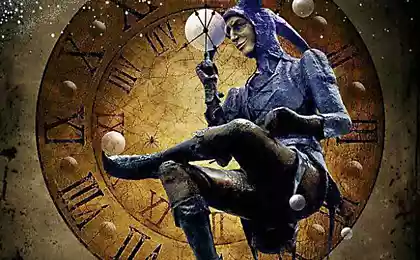528
The illusion of objectivity: why do we see only what we want
Everyone believes in their objectivity. We think that we are observant enough to find all the evidence against the theory that we adhere to — and if this evidence is not enough, then the theory is correct. But what if the brain filters out any — even visual — information in accordance with our beliefs? If we can remain impartial, or even our neuroscience contradicts this? Journalist Tom Vanderbilt talks about the paradoxes of perception in the article on the website Nautil.us.

© Tim O'brien
Palmer field, Princeton, 1951. The traditional autumn game of American football: undefeated Princeton "tigers" with their famous tailback Dick Kazmaier, against a team like Dartmouth. In the game, with many penalties Princeton managed to win over the "big green", but its price was high: about a dozen players were injured, and Kazmaier finished the match with a broken nose and a concussion. As gently put it "The New York Times", it was "foul play, which led to mutual accusations by the two teams." Each claimed that the opponents were playing dirty.
The story appeared not only in the pages of sports publications, but also in the "Journal of abnormal and social psychology". Shortly after this incident, psychologists albert Hastorf and Hadley were Cantril conducted a survey among students, showing them a video of the match. They had to decide which of the teams started playing dirty. But opinions of the subjects about the game that either team was incredibly biased, and the researchers came to an unexpected conclusion: "evidence suggests that there is no separate phenomenon of the "game" that exists outside of the minds of the people." Everyone saw that the game wanted to see. But how? Perhaps they were an example of what he was talking about the father of "cognitive dissonance" Leon Festinger: "People perceive and interpretiruya information to satisfy their own beliefs."
When the students watched and analyzed the video of the match, they acted like children, who saw the illusion of the famous "duck-rabbit". If the picture showed on Easter Sunday, the children often saw the rabbit, although any other Sunday most saw the duck. The picture itself can be interpreted in two ways, and switching from one image to another requires effort.
In the experiment, Alison Gopnik and her colleagues no child in a group of 3 to 5 years not able to switch from one image to another (they showed the illusion of the "vase-face"). In the group of older children, but still "naive", switch did the third. Almost everyone else did it, when they hinted at the duality of the image. Interestingly, children who were able to recognize both images, also did a better job on the "theory of mind" — the ability to understand the subjectivity of his perception in relation to the external world (for example, children were shown a box of crayons inside which really was the spark, and then asked me to guess, I'd think about the contents of the box other child, who saw her).

Even if you can not initially see a duck and a rabbit, do not worry: in all such studies found adults "probably with a more complex representational abilities," unable to "switch". There is also no single correct interpretation of the image: although there is some tendency to see rabbits, duck people also full.
At some point, everyone can see the duck-rabbit, but there is one thing that unable anyone: no matter how you try, you will not be able to see the duck and rabbit simultaneously.
I asked Lisa Feldman Barrett, head of the Laboratory for interdisciplinary affective Sciences at northeastern University in Boston, do we not live in a kind of metaphorical duck-rabbit world. Her response was brief: "I Think, not in a metaphorical". Our brain is designed in such a way that the internal connections between neurons are much more than those for which sensory information coming from outside. "The brain itself provides an incomplete picture need details," she says, "to give specific meaning to ambiguous sensory data."
Lisa Feldman Barrett calls the brain a "jammer". In accordance with the increasingly popular hypothesis of "predictive coding", the perception is generated by our own brain, and only corrected external information. Otherwise, he would have to handle too much data. "It's irrational," she says, "the brain needs workarounds". Therefore, it is constantly predicts. When the "incoming sensory information is necessary to change either the forecast or the information itself".

This link between external sensory information and internal beliefs and predictions have long interested scientists. The study, published in "neuropsychologia is", subjects were asked to decide whether the statement about the connection of color and object (e.g., "banana is yellow"). At the same time in their brain is activated the same areas that a regular distinction of color. Brain didn't make any difference, does the holder of a real yellow or think about a yellow banana. This "re-perception" similar to the mechanism of memories (though the researchers note "a different nature of perception and reproduction of knowledge").
Information from the outside world comes to us through a narrow window of perception and forms our beliefs. But then those beliefs act like a lens, focusing on what they need to see. Last year in the Laboratory of psychology at new York University to a group of people were shown 45-second recording of violent fights between the police and unarmed person. It was unclear whether correctly the police behaved towards the man he tried to twist. Before the screening of the study participants were asked how they identify themselves with the police in General. After the screening, during which they tracked the eye movements of the subjects, they had to decide which of the fighters wrong. Naturally, more strictly condemned the actions of the police, those who were less favorable to him initially. But that was only if they longer looked at him. The solution to those who watched it less, does not depend on their original relationship to the police.
According to Emily Balcetis, head of Laboratory of social perception, activities and motivations at new York University and co-author of the study, we tend to think that our preferences are formed as a result of conscious decisions. "But what thought processes precede these decisions?" — asks Balcetis. — "Mindfulness is simply what you allow to see your eyes." In the case of video with the police "movement your eyes make a completely new understanding of existing facts." Those who most strongly condemned the actions of the police officer, looked at him more often (and, as in the case of the duck-rabbit, probably could not simultaneously see him and detained). "If someone you don't like," says Balcetis. "You look at him more. You will always keep track of who is a potential threat."
But what influences such a situation? It's hard to say for sure. In numerous studies of subjects there is the characteristic neural response when an image of a person from their race. But what happens if you say that the people in the photographs — a kind of "team", which belongs to the subject? "Approximately the first 100 milliseconds we solve the problem of the rabbit-duck," says Jay van Bavel, Professor of psychology at new York University. Who do you see — on your team or a person of another race? The study of van Bavel found a positive neural activity in response to images of the "team members", while a racial characteristic becomes completely insignificant (as in the case of the duck-rabbit, we are capable of only one interpretation at a particular point in time).
However, taking any decision, we will stubbornly insist on it. Giving debt the respect of the duck-rabbit, Balcetis colleagues conducted an experiment in which a group of people were shown images of "sea animals" and "livestock". The subjects were asked to choose which of the two shown in the picture: for every answer they either gained points or lost (note: some received points for "marine animals" and lost in "livestock", other — Vice versa). Finished the game with a positive score, they were awarded the packaging of marmalade. If the score was negative, they got "Bank liquid of canned beans". The decisive moment came at the end, when subjects saw a vague image whether horse, or seal (the seal was a bit harder to see). In order not to choke on the ill-fated beans, they had to recognize the image for which they would have scored points. And most succeeded. But what if they saw both images and said only that which was to bring them the win? The experiment was repeated with new participants, but this time tracked the movement of their eyes. Those who need to find more "livestock" often watched on the button "livestock" (after clicking it, the answer would be counted and they would be moved to the next question), and Vice versa. A glance at the button "right" (in their opinion) answer were given their intentions without any calculation of brain activity. First choice did their vision.Even if the experiment was simulated by a computer error and the subjects were told: "sorry, this is actually "sea animals" would have saved you from liquid beans", most still insisted on his original interpretation of the image even in the light of new motivation. "They are unable to look at the image, already established in their minds," says Balcetis. "because if you give ambiguous phenomenon specific meaning, it ceases to be ambiguous."
A recent study Cara Federmeyer shows that something similar occurs with the formation of memories. It was considered a misconception about the program of a political candidate — as in the case when most people believed that Michael Dukakis, not George Bush going to be the "President-educator". Studies of brain activity of subjects using EEG found that the signals are false and correct memories are virtually identical. Personal version of the incident is so entrenched in the minds of the subjects that was true.
Such "fixation" can occur unconsciously. In the course of published in the "Pediatrics" study of more than 1,700 parents in the United States received for review brochure one of four campaigns to dispel the myths about the dangers of liquid measles vaccine. According to the study, none of the campaigns had no impact on the decision of parents to vaccinate. Yes, the original opponents of vaccines have little doubt that it causes autism. But together they are even more convinced that to do ZHKV impossible. Image swollen and covered with a rash children only strengthened the faith of the parents in its dangerous side effects.
It is unclear exactly how this consolidation, and why a man can suddenly change his mind and switch from duck to rabbit. The debate about how change occurs, has long been underway and continue to this day. Some arguments speak in favor of this bottom-up process: the neurons telling you that before you duck, get tired or "saturated", giving place to new information — about rabbit.
Another possible mechanism is "down" — suggests, the switch occurs in the higher parts of the brain: if we already know something, we expect and strongly to look for it. If we tell a person that he didn't try to switch, it most likely will not do it — unlike the man asked to switch as quickly as possible.
Jürgen Cormier with colleagues from the Institute of the latest research in the field of psychology and mental health in Freiburg, Germany, proposed a hybrid model that combines both mechanisms. As Cormier told me, even at a very early age, the activity of the eye and visual system affect the "top-down" processes, so we cannot say that information is perceived unilaterally. He suggests that even if we did not notice a duck or a rabbit, our brain subconsciously recognizes both images, but found one unreliable and did not tell us about it. And then it turns out that your own mind is aware of what is happening, but you remained out in the cold. published
P. S. And remember, just changing your mind — together we change the world! ©
Source: theoryandpractice.ru

© Tim O'brien
Palmer field, Princeton, 1951. The traditional autumn game of American football: undefeated Princeton "tigers" with their famous tailback Dick Kazmaier, against a team like Dartmouth. In the game, with many penalties Princeton managed to win over the "big green", but its price was high: about a dozen players were injured, and Kazmaier finished the match with a broken nose and a concussion. As gently put it "The New York Times", it was "foul play, which led to mutual accusations by the two teams." Each claimed that the opponents were playing dirty.
The story appeared not only in the pages of sports publications, but also in the "Journal of abnormal and social psychology". Shortly after this incident, psychologists albert Hastorf and Hadley were Cantril conducted a survey among students, showing them a video of the match. They had to decide which of the teams started playing dirty. But opinions of the subjects about the game that either team was incredibly biased, and the researchers came to an unexpected conclusion: "evidence suggests that there is no separate phenomenon of the "game" that exists outside of the minds of the people." Everyone saw that the game wanted to see. But how? Perhaps they were an example of what he was talking about the father of "cognitive dissonance" Leon Festinger: "People perceive and interpretiruya information to satisfy their own beliefs."
When the students watched and analyzed the video of the match, they acted like children, who saw the illusion of the famous "duck-rabbit". If the picture showed on Easter Sunday, the children often saw the rabbit, although any other Sunday most saw the duck. The picture itself can be interpreted in two ways, and switching from one image to another requires effort.
In the experiment, Alison Gopnik and her colleagues no child in a group of 3 to 5 years not able to switch from one image to another (they showed the illusion of the "vase-face"). In the group of older children, but still "naive", switch did the third. Almost everyone else did it, when they hinted at the duality of the image. Interestingly, children who were able to recognize both images, also did a better job on the "theory of mind" — the ability to understand the subjectivity of his perception in relation to the external world (for example, children were shown a box of crayons inside which really was the spark, and then asked me to guess, I'd think about the contents of the box other child, who saw her).

Even if you can not initially see a duck and a rabbit, do not worry: in all such studies found adults "probably with a more complex representational abilities," unable to "switch". There is also no single correct interpretation of the image: although there is some tendency to see rabbits, duck people also full.
At some point, everyone can see the duck-rabbit, but there is one thing that unable anyone: no matter how you try, you will not be able to see the duck and rabbit simultaneously.
I asked Lisa Feldman Barrett, head of the Laboratory for interdisciplinary affective Sciences at northeastern University in Boston, do we not live in a kind of metaphorical duck-rabbit world. Her response was brief: "I Think, not in a metaphorical". Our brain is designed in such a way that the internal connections between neurons are much more than those for which sensory information coming from outside. "The brain itself provides an incomplete picture need details," she says, "to give specific meaning to ambiguous sensory data."
Lisa Feldman Barrett calls the brain a "jammer". In accordance with the increasingly popular hypothesis of "predictive coding", the perception is generated by our own brain, and only corrected external information. Otherwise, he would have to handle too much data. "It's irrational," she says, "the brain needs workarounds". Therefore, it is constantly predicts. When the "incoming sensory information is necessary to change either the forecast or the information itself".

This link between external sensory information and internal beliefs and predictions have long interested scientists. The study, published in "neuropsychologia is", subjects were asked to decide whether the statement about the connection of color and object (e.g., "banana is yellow"). At the same time in their brain is activated the same areas that a regular distinction of color. Brain didn't make any difference, does the holder of a real yellow or think about a yellow banana. This "re-perception" similar to the mechanism of memories (though the researchers note "a different nature of perception and reproduction of knowledge").
Information from the outside world comes to us through a narrow window of perception and forms our beliefs. But then those beliefs act like a lens, focusing on what they need to see. Last year in the Laboratory of psychology at new York University to a group of people were shown 45-second recording of violent fights between the police and unarmed person. It was unclear whether correctly the police behaved towards the man he tried to twist. Before the screening of the study participants were asked how they identify themselves with the police in General. After the screening, during which they tracked the eye movements of the subjects, they had to decide which of the fighters wrong. Naturally, more strictly condemned the actions of the police, those who were less favorable to him initially. But that was only if they longer looked at him. The solution to those who watched it less, does not depend on their original relationship to the police.
According to Emily Balcetis, head of Laboratory of social perception, activities and motivations at new York University and co-author of the study, we tend to think that our preferences are formed as a result of conscious decisions. "But what thought processes precede these decisions?" — asks Balcetis. — "Mindfulness is simply what you allow to see your eyes." In the case of video with the police "movement your eyes make a completely new understanding of existing facts." Those who most strongly condemned the actions of the police officer, looked at him more often (and, as in the case of the duck-rabbit, probably could not simultaneously see him and detained). "If someone you don't like," says Balcetis. "You look at him more. You will always keep track of who is a potential threat."
But what influences such a situation? It's hard to say for sure. In numerous studies of subjects there is the characteristic neural response when an image of a person from their race. But what happens if you say that the people in the photographs — a kind of "team", which belongs to the subject? "Approximately the first 100 milliseconds we solve the problem of the rabbit-duck," says Jay van Bavel, Professor of psychology at new York University. Who do you see — on your team or a person of another race? The study of van Bavel found a positive neural activity in response to images of the "team members", while a racial characteristic becomes completely insignificant (as in the case of the duck-rabbit, we are capable of only one interpretation at a particular point in time).
However, taking any decision, we will stubbornly insist on it. Giving debt the respect of the duck-rabbit, Balcetis colleagues conducted an experiment in which a group of people were shown images of "sea animals" and "livestock". The subjects were asked to choose which of the two shown in the picture: for every answer they either gained points or lost (note: some received points for "marine animals" and lost in "livestock", other — Vice versa). Finished the game with a positive score, they were awarded the packaging of marmalade. If the score was negative, they got "Bank liquid of canned beans". The decisive moment came at the end, when subjects saw a vague image whether horse, or seal (the seal was a bit harder to see). In order not to choke on the ill-fated beans, they had to recognize the image for which they would have scored points. And most succeeded. But what if they saw both images and said only that which was to bring them the win? The experiment was repeated with new participants, but this time tracked the movement of their eyes. Those who need to find more "livestock" often watched on the button "livestock" (after clicking it, the answer would be counted and they would be moved to the next question), and Vice versa. A glance at the button "right" (in their opinion) answer were given their intentions without any calculation of brain activity. First choice did their vision.Even if the experiment was simulated by a computer error and the subjects were told: "sorry, this is actually "sea animals" would have saved you from liquid beans", most still insisted on his original interpretation of the image even in the light of new motivation. "They are unable to look at the image, already established in their minds," says Balcetis. "because if you give ambiguous phenomenon specific meaning, it ceases to be ambiguous."
A recent study Cara Federmeyer shows that something similar occurs with the formation of memories. It was considered a misconception about the program of a political candidate — as in the case when most people believed that Michael Dukakis, not George Bush going to be the "President-educator". Studies of brain activity of subjects using EEG found that the signals are false and correct memories are virtually identical. Personal version of the incident is so entrenched in the minds of the subjects that was true.
Such "fixation" can occur unconsciously. In the course of published in the "Pediatrics" study of more than 1,700 parents in the United States received for review brochure one of four campaigns to dispel the myths about the dangers of liquid measles vaccine. According to the study, none of the campaigns had no impact on the decision of parents to vaccinate. Yes, the original opponents of vaccines have little doubt that it causes autism. But together they are even more convinced that to do ZHKV impossible. Image swollen and covered with a rash children only strengthened the faith of the parents in its dangerous side effects.
It is unclear exactly how this consolidation, and why a man can suddenly change his mind and switch from duck to rabbit. The debate about how change occurs, has long been underway and continue to this day. Some arguments speak in favor of this bottom-up process: the neurons telling you that before you duck, get tired or "saturated", giving place to new information — about rabbit.
Another possible mechanism is "down" — suggests, the switch occurs in the higher parts of the brain: if we already know something, we expect and strongly to look for it. If we tell a person that he didn't try to switch, it most likely will not do it — unlike the man asked to switch as quickly as possible.
Jürgen Cormier with colleagues from the Institute of the latest research in the field of psychology and mental health in Freiburg, Germany, proposed a hybrid model that combines both mechanisms. As Cormier told me, even at a very early age, the activity of the eye and visual system affect the "top-down" processes, so we cannot say that information is perceived unilaterally. He suggests that even if we did not notice a duck or a rabbit, our brain subconsciously recognizes both images, but found one unreliable and did not tell us about it. And then it turns out that your own mind is aware of what is happening, but you remained out in the cold. published
P. S. And remember, just changing your mind — together we change the world! ©
Source: theoryandpractice.ru
Fried ice cream — unusual and very simple!
Scientists have discovered creatures living in the crater of an active volcano























